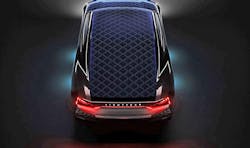Solar at Tipping Point of Mass Adoption in EVs, Says IDTechEx
The following article was originally published in eeNews Automotive. It is reprinted here with permission.
Startups Sono Motors and Lightyear announced solar family cars available as of next year. They have solar bodies rather than the useless scrap of solar roof seen on other cars. That means many owners will never plug in, observes Raghu Das, CEO of market research firm IDTechEx.
Shown is the Lightyear One, which has a solar body.
They do not have the acceleration of a Tesla, but Lightyear cheekily points out that its Lightyear One will go 740 km faster than any Tesla because the Tesla would have to stop and plug in. According to Das, the major car companies should be ashamed of those two startups taking well over $200 million of their business within one year with these attractive propositions. True, Hyundai is now on the job, announcing three large solar roof designs, one for pure electric cars, one for hybrids, another promised to be semi-transparent when available. None will make a Hyundai energy-independent for anyone. Nonetheless, some Hyundai users will get over 10% of their electricity from daylight, given typical distances driven. Toyota, Hanergy and others are experimenting with more expensive, even more efficient chemistry giving at least one kilowatt per kilogram. That means even cars grabbing at least one kilowatt per vehicle.
Tesla has now joined the solar party with an option on its Cybertruck. At the launch in November 2019 he said, “There will be an option to add solar power that generates 15 miles per day, possibly more. Would love this to be self-powered. Adding fold out solar wings would generate 30 to 40 miles per day. Average miles per day in US is 30.”
Musk had previously discussed the idea of a “deployable solar shield like a retractable hard top” for electric vehicles. That feature could particularly be useful with the Cybertruck camper configuration that Tesla is planning to offer as an option. The chemistry was not revealed but we expect it to be the now mainstream single crystal silicon.
IDTechEx also notes that the Chinese plan to make the more efficient single crystal silicon more popular even than today’s workhorse polycrystalline silicon on a house near you by massive new capacity leading to robust cost reduction. Much more efficient means you get more electricity, or you need less area. The research firm expects Tesla to charge a few thousand dollars for the huge solar top, very attractive to those buying the $50k plus premium versions of the pickup. Another tens of thousands a year sale of solar cars should result.
Days later came the announcement of the Squad City Solar car, another example of solar in at the very start of the concept. This 45 km/h, 2-person solar car for daily (sub)urban mobility is being developed by two ex-Lightyear employees who share a desire to develop an affordable solar car for a large group of consumers. The Squad is already available for pre-order in the EU. Retail price starts at a mere € 5750 (ex. VAT), so it is very affordable, as is the 5-seat Sono Sion solar car. An 80 km/h Squad will also be offered later. The Squad offers space for two passengers sitting side by side, and a storage compartment in the back. Two children (up to 1.25 m) can sit on rear seats where legally permitted.
A lineup of Squad Mobility's Squad City Solar cars.
“We are clearly at the tipping point for adoption of solar on land, water and air vehicles, particularly on pure electric ones where range sells. There are now camper vans, delivery trucks, robot shuttles, buses, boats and even aircraft getting at least 10% and often all of their electricity from daylight. Many find it useful even on the sides of their vehicles. Any designer of any electric vehicle must now seriously consider solar bodywork. It is a new key enabling technology”, says Das.
The CEO derives all of these observations and anticipations from a new IDTechEx report titled “Solar Cars, Buses, Trucks, Trains 2020-2030” focusing on the technology analysis and market forecasting for the integration of solar energy harvesting in cars.
About the Author
Julien Happich
Julien Happich is Editor in Chief of eeNews Europe.



